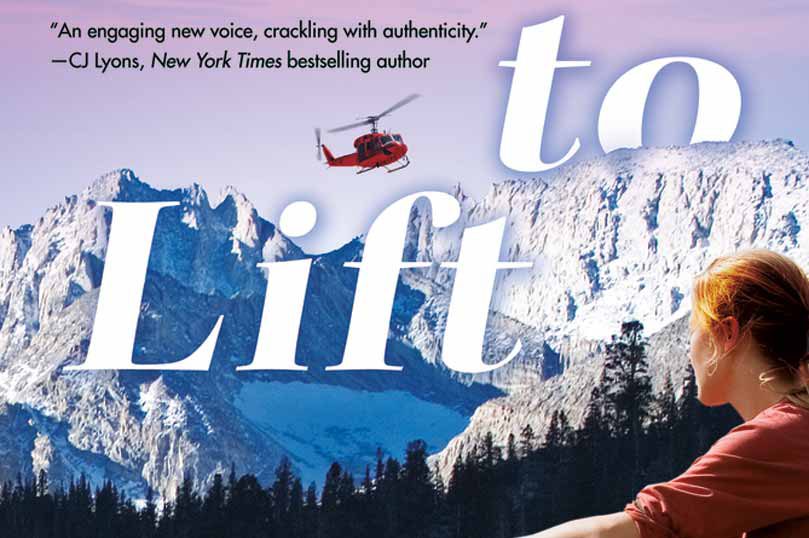 Navy helicopter pilot Lt. Alison Malone has been assigned to a search and rescue team based at Naval Air Station Fallon, Nevada, near the rugged peaks of the Sierra Nevada, and far from her former elite H-60 squadron. A rule follower by nature, Alison is exasperated and outraged every time she flies with her mission commander, “Boomer” Marks, for whom military procedures are merely a suggestion. Alison is desperate to be transferred out of the boonies, where careers stagnate, and back to her life and fiancé in San Diego.
Navy helicopter pilot Lt. Alison Malone has been assigned to a search and rescue team based at Naval Air Station Fallon, Nevada, near the rugged peaks of the Sierra Nevada, and far from her former elite H-60 squadron. A rule follower by nature, Alison is exasperated and outraged every time she flies with her mission commander, “Boomer” Marks, for whom military procedures are merely a suggestion. Alison is desperate to be transferred out of the boonies, where careers stagnate, and back to her life and fiancé in San Diego.
Alison’s defenses start to slip when she meets mountain guide Will Cavanaugh during a particularly dicey mission. Will introduces her to a wild, beautiful world of adventure that she has never known before. Stranded on a mountain during a sudden dangerous blizzard, Alison questions every truth she thought she knew about herself. When Will braves the storm to save her life, she must confront the fact that she has been living a lie. But is it too late to change course?
Clear to Lift will be available July 12th. Please enjoy this excerpt.
1
Agitated snow tumbles and whirls across the cockpit windshield. I strain to see through it, to make out three figures clinging to a vertical wall of ice. Two are unmoving, dangling like rag dolls from the ends of a climbing rope. One, wearing a bright yellow jacket and neon-orange gloves, scampers up from below, gripping two ice axes, feet and hands a flurry of movement, scrambling up, up, up, over two hundred feet above the ground, and without a … rope?
“He doesn’t have a rope!” I say, squinting to be sure.
Although, wait. Maybe … it’s an optical illusion. We are flying at ten thousand feet, skirting the edge of a rock buttress three thousand feet high.
Yeah, right, Alison. You know why you can’t tell …
“You sure about that?” says Commander Benjamin “Boomer” Marks, the aircraft commander for the flight. A former offensive tackle for the University of Wyoming, he still packs every pound of his football-glory-days girth.
“No, sir, I’m not sure. Why? Because I can’t see a flippin’ thing! Which is what happens when you fly in a freakin’ snowstorm! Which, by the way, goes against every—”
“You mean, this insignificant nothing of a snow squall? The one we’ve been flying in for all of fifteen seconds? The one that’ll pass just as fast?”
“But what about—?”
“The deicing system is on, Malone. And look,” he says, motioning with his head to the outside. “It’s past history, anyway.”
The snowflake assault abruptly fades to nothingness.
“See? Already through it.” He flashes an I-told-you-so grin as we transition into improbably clear air, albeit in the midst of disturbingly unsettled weather—the clouds hanging heavy, threatening.
We’re doing a low-speed flyby, like we always do when called to a rescue, but at least now we have an unrestricted view of the fast-moving, agile climber, who apparently does not require a rope when scuttling up a frozen rock face hundreds of feet above the ground. I lean in my seat as far as the straps will allow, peering into a narrow couloir—a steep tunnel of snow and ice—that splits the east face of the formidable Mount Morrison.
“That is some serious risky shit,” says our ace crew chief, Beanie, otherwise known as Petty Officer First Class Billy Hilfenbein. “Soloing the Death Couloir? Jesus, Will.”
“Will? Who’s Will?” I ask.
“That loony!” Beanie pokes his head between the cockpit seats and points to the climber in yellow. “Lieutenant Malone, meet Will Cavanaugh, one of the best all-around mountaineers in the world.”
“Like literally the world, ma’am,” our star paramedic, Hap—officially Petty Officer First Class Hap Gentry—says. “The guy should like wear a cape or something.”
“Is he new, Hap? I’ve never heard of him.”
“He left for the Himalaya right after you checked in, ma’am. About four months ago, I think.”
“Best climber on the Mono County SAR Team,” Beanie says.
I watch, transfixed, as Will ascends Spiderman-like, quick and sure, negotiating the last few feet to the first victim.
“Rescue Seven, Mono County Sheriff, over.”
“Mono County Sheriff, Rescue Seven has you loud and clear,” Boomer says. “Whaddya got for us, Jack?”
“Just an update,” says Jack Smith, head of the Mono County Search and Rescue Team. He briefed the rescue scenario with us via radio during our transit—two climbers stranded, hit by rockfall—and reports now from the base of the mountain, where he waits with the rest of the ground crew, watching with binoculars, over six thousand feet below us. “As you can see, Will’s almost to the first victim. He passed the belayer on the way up, who’s conscious, possible broken arm. But the belayer thinks the lead guy is worse off. He’s been in and out of consciousness.”
“Roger that,” Boomer says. “We’ll plan for the lead guy, first. We’re rigged for rappel.”
And then to me. “Ready for the controls, Alison?”
I bring my gloved hands to my mouth and give a quick blow of hot air—god bless, it’s cold—before placing them on the flight controls. “I’ve got the controls.”
“Rescue Seven, Whiskey One,” a voice crackles on the radio. It must be Will. “I’m at the first victim now. He’s thirty-five years old, awake, alert, oriented. He was hit by rockfall and caught by his rope when he fell. He’s hanging right side up. Man reports loss of feeling from the waist down. Suspect spinal injury. After we get him off, I’ll down-climb to the second victim, over.”
“Whiskey One, Rescue Seven copies,” I say. “Inbound.”
I roll the aircraft to the left, rotor blades thwacking the air—thwack, thwack, thwack—continuing to arc around, until I arrive in a hover about forty feet away from the rocks, fifty feet above Will. I orient the helicopter parallel to the rock wall, sensing the winds more intimately now that I’m at the controls. Crap. I hate the winds in close quarters. Add to this, mushy flight controls, the result of not enough air particles at this altitude for our rotor blades to grip, and it means the aircraft is slow to react to my inputs. Crap and crap.
At least you’re not flying in the snow. Could be worse.
Wait. Don’t say that.
“Okay, ma’am,” Beanie says. “Ready to slide right?”
“Ready.”
“Clear to slide right thirty, right twenty, right ten … right ten … Ma’am? I need you to slide right ten.”
“Beanie, isn’t this close enough?”
I’d swear the rotor tips are less than ten feet from the wall now. No way we can slide farther.
“No, ma’am, we’re gonna need to get closer.”
My mind whirs. Rotor clearance limits. Ten feet of horizontal clearance required for the main rotor. Same for the tail rotor.
“Sir, I don’t know if we can do this. I don’t think we’re in rotor clearance limits.”
“There are no limits,” Boomer says.
“What? It’s ten feet! It’s—”
“In training, yes. If it’s the real deal, the only limits are your own.”
“Please tell me that’s not a Bruce Lee quote.”
“I’m paraphrasing.”
I peer out my side window at an unmoving face of black granite that is right there.
“I hate to break it to you, Malone, but you’re rock-steady in this hover, and you have the ability to do this. Not to mention, the guy with a spinal injury down there would appreciate the help.”
“Ma’am, why don’t we try it right here to start?” Beanie suggests. “Once Hap’s on the rope, he can try to swing over to the victim.”
“Let’s try that,” I say, copping out completely. Coward.
“Roger that. Stand by,” Beanie says.
I can’t see Boomer, because I’m looking out my right window, but his disappointed stare bores into the back of my skull. Will and the victim below remain out of sight, as well. Instead, I focus on a deformation in the rock face and hold there. If I keep the helicopter in this relative position to the rock, we should remain clear. Should …
Bracingly cold air sweeps into the cockpit when Beanie opens the cabin door, doing a thorough job of penetrating the thin material of my flight suit. Even though I’m wearing long underwear, it doesn’t make a bit of difference. The early-season winter storm that dropped ten inches of new snow on the Sierra Nevada yesterday also brought single-digit temperatures with it.
“Okay, ma’am, Hap’s at the door. Clear to exit?”
“Clear!”
“Hap’s exiting the aircraft,” Beanie calls. “He’s on the skids. Steady right there. I’m goin’ up hot mic.”
He’ll have to. He’ll need to be hands-free on the mic to do all the rope handling and hoisting.
The wind buffeting. There it is again. It was somewhat negligible when we were flying at speed away from the rocks, but when you’re attempting to hold a hover in a confined area, tiny wind gusts seem to morph into something convincingly more violent.
“Looking good on the gauges,” Boomer says. “Nice and steady on the controls.”
Hap stands on the skids—our landing gear that looks like skis—facing the helicopter’s open door. He wears his climbing harness, to which a rappel device is attached, and a rope runs through this, secured on one end to the anchoring system in the helicopter, while the rest of the rope hangs far below.
“Hap’s ready on the rappel, ma’am.”
“Clear to jump,” I say.
“Copy. Man’s off the skids!”
Hap leaps backward and slides several feet down the rope to arrive below the skids. From there, he lowers himself the roughly fifty feet to Will and the first victim.
“Hap’s adjacent the victim,” Beanie says. “Starting his swing.”
“Copy,” I say, imagining Hap kicking his legs out, like you would on a playground swing, to get the rope moving back and forth, so he can move into a position where he can reach the rocks.
“Swingin’ good now!” Beanie says, although the call really isn’t necessary, as we can all feel the helicopter rocking.
Come on, Hap. You can do this. Please do this.
As Beanie makes his calls, informing the crew of Hap’s progress, I blink my right eye, trying to clear the drop of sweat—sweat?—that just dripped there. It irritates, stings a bit, but I can’t move my hands from the controls to wipe it.
“Ma’am, I’m gettin’ a negative hand signal from Hap!”
“What?” Oh, no. “Can’t he—?”
“No, ma’am. He can’t reach the victim! We’re gonna have to slide closer, if we’re gonna make this happen!”
Closer …
“Sir?” I ask, reaching for a lifeline.
“You got this, Alison. You haven’t budged since we started. I know you can do it.”
I grind my teeth, and a steady trickle of sweat—oh yeah, it’s running now—slides down the back of my neck.
“Ma’am?” Beanie asks.
Deep breath in. Oh … all right. Shit. “Call me right.”
“Okay, ma’am, you’re clear to slide right eight,” Beanie says, using the number of feet to the stopping point he’s chosen. “Clear to slide right five, right four, three, two, one, steady. Steady right there, ma’am. We’ve got two feet of clearance at the blade tips.”
“Copy,” I say, my jaw throbbing because it’s clenched so tight.
Two feet from blade tip to solid rock. Sweat-inducing for sure, and by far the most difficult rescue scenario I’ve faced in my short tenure with this squadron.
“And only one foot of clearance at the tail,” Beanie continues. “Do not move the tail rotor right.”
Gulp. “Copy.”
The icy chill I felt earlier disappears as I become the literal embodiment of the phrase “You’re in the hot seat.” Perspiration blooms. I try not to think about the men in this aircraft who are entrusting their lives to me. Trusting I won’t waver. Trusting I won’t move the cyclic those tiny few millimeters to the right that would send us smashing into the side of this mountain. Trusting I’ll be able to manipulate the rudder pedals in time, if hit by a downdraft, before the tail spins. My grip tightens on the controls, my body rigid from the toes up.
“Hap’s at the victim,” Beanie says, continuing the play-by-play. “Hover’s lookin’ good. No rise, no drift. Nice and steady, ma’am.”
“Still good on the gauges,” Boomer says. “You’re a rock on the controls.”
“Tying off the belay!” Beanie says, huffing. On hot mic, you hear everything. Grunting, breathing, and the occasional stress-induced epithet. “Belay line is tied. Lowering the litter. Nice and steady on the hover, ma’am. Lookin’ good.”
As Beanie lowers the litter on the hoist cable, Hap is able to tug on the trail line below, keeping it taut so the litter doesn’t swing. The litter is oriented vertically to match the position of the victim. This way, Hap and Will can slide the litter behind the victim and keep him in an upright position while strapping him in.
I blink continually to keep the rock deformation in focus. The longer I stare at it, the more the eyes play tricks. From where I sit, I have no reference to a straight horizon. So easy to drift without a horizon.…
Damn it. My hands, slick with sweat, are slipping inside my gloves.
The wind gust hits, and I’m already pressing right pedal when Beanie’s oh-so-calm voice comes through my helmet. “Pivot the nose easy right, ma’am. That’s it. Still a foot of clearance at the tail. Nice and steady. Hap’s loading the man in the litter. Stand by.”
I start to wonder if I might draw blood, gnawing as I am on the inside of my cheek. My head pounds, straining from the concentration. Keep it steady, Ali. You’ve got this.
“Nice and steady, ma’am,” Beanie calls. “Man’s in the litter. Bringing tension in the hoist. We have a thumbs-up. Victim’s on the way up … he’s halfway up … he’s at the skids. Stand by. Bringing the litter in.…”
Hap remains on the rock below, still secured to the helicopter by his rappel rope and the belay line, as Beanie hauls the litter into the helicopter. After the victim is secure inside, Beanie will send the hoist down to get Hap, which means I only need to hold the helicopter in this tenuous position just a few more minutes.
“Shit!” Beanie shouts. “The guy’s not breathing! No pulse! We gotta go ASAP!”
Shit! Hap is still fifty feet below us.
“Hap, the victim just crashed!” Boomer says. “Strap in, Doc, you’re goin’ for an e-ticket ride!”
“Ma’am, you’re clear to slide left! Starting CPR!”
“Copy, sliding left!”
I sweep the cyclic to the left as Hap hangs on tight, attached to the ropes below us. He’ll “fly” like this all the way to the hospital, because we have no easy way to bring him up.
“… and twelve and thirteen and fourteen and fifteen…,” Beanie huffs as he counts out chest compressions. “… twenty-one, twenty-two, twenty-three, twenty-four…”
“Jack, we’re gone,” Boomer reports. “The guy went into cardiac arrest. Be back for the second guy shortly.”
“Mono County copies.”
“Mammoth Hospital, Rescue Seven,” I say.
“Rescue Seven, Mammoth, go ahead.”
“Mammoth, we’ve got a thirty-five-year-old man who was ice climbing and hit by rockfall,” I say. “He was caught by his rope when he fell. Awake and alert when we got to him, complained of no feeling in his legs. While hoisting him up, he went into cardiac arrest. We’ve initiated CPR. Inbound. ETA four minutes.”
“… fifty-four, fifty-five, fifty-six, fifty-seven…”
And then to Will, “Whiskey One, Rescue Seven, over.”
“Go ahead, Rescue Seven.”
“Be advised, victim stopped breathing, and we’ve initiated CPR. En route to Mammoth Hospital.”
“Rescue Seven, Whiskey One copies. Climbing down to second victim now.”
I stretch my fingers, while still holding the controls, in an effort to relieve the tension. My toes remain numb, even though the rest of my body is soaked in sweat.
But who am I to complain? I peer around my cockpit seat to view Beanie in the cabin. He’s hunched over the victim, arms locked and straight, the model of concentration, banging out chest compressions. Sweat drips from his face, even though the main cabin door remains wide open, the grunts and huffs ringing loud and clear.
“… ninety-three, ninety-four, ninety-five, ninety-six…”
Copyright © 2016 by Anne A. Wilson
Buy Clear to Lift from:












